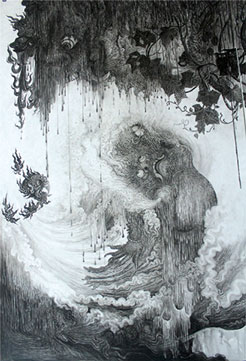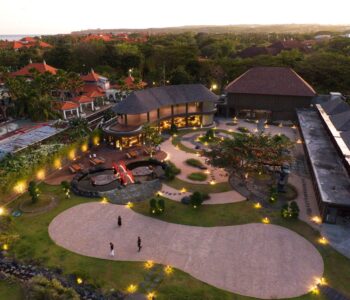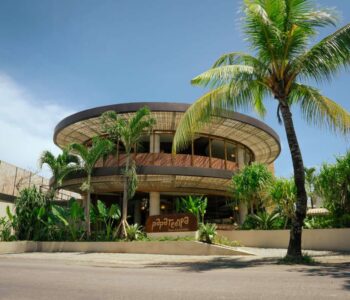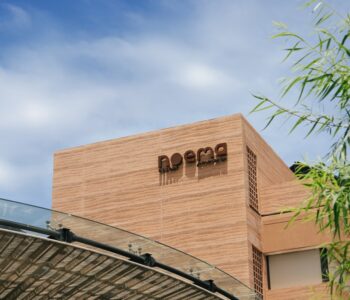
The Balinese have an ambiguous attitude toward the sea. The sea opens to the exterior world and is therefore threatening and promising at once. Deadly grubug (diseases) arrive from the sea, sent to the island, as people say, by the evil king Jero Gede Mecaling. All around the island’s coast are small altars from which offerings are addressed to the monster king.
Similarly, cultural influences are known to come from the sea. The sage Merkandaya pondered for years, from the slopes of Mount Raung, in Java, whether he and his followers should come and settle on the island. When they did, they brought with them the gods of Hinduism. In the 16th century, the holy priest Nirartha arrived from Java to set up a series of temples protecting the island from the Islamic world outside, while undertaking at the same time a reform of Balinese Hinduism.
Some anthropologists view the sea as a pole of impurity and the negative, opposed to mountains, which are viewed as a pole of purity and the positive. But things are more complex. If there indeed is such polarity, as stated in the Rwabhinneda principle of complementariness of the opposite, the educated Balinese will tell you, that the positive also dwells in the negative, and the negative in the positive. The sea has its demons, as well as its gods, some of which are demonic. The most famous is Baruna, the god of the sea, the Balinese Neptunus.
The sea is in fact primarily viewed as a cleansing medium. And the most difficult things to cleanse are human remains. Upon death, the remains of the body – the ashes from the cremation (aben) pyre – are thrown into the sea (anyudang ke segara). People say that the soul of the deceased is entrusted to the care of Baruna, who will look after it until completion of the post-cremation rites. It is during that period that the soul is believed to be tortured, and thus cleansed in Balinese purgatory (swarga), located somewhere in the depths of the sea.
The cleansing continues with the post-cremation rites, when people go to the sea to “call back” the soul entrusted to Baruna and “install” it in an offering. This offering will then be burned in a mukur/ngasti ceremony at the end of which another rite will take place by the sea, whereby the offering ashes and the accompanying soul, also set in offerings, are sent away into the sea in a small outrigger boat. The soul proper will later on be enshrined in the family temple for worship.
All those ceremonies aim at separating the five physical elements of the deceased person (air, water, fire, “earth” and void) from their cosmic equivalents (Panca Maha Buta), thus enabling the soul to rejoin the “Old Country” above the mountain and come back “asking for rice” (nunas baas), thus incarnate when its time has come.
Thus the sea is par excellence the receptacle of impurity, which it also cleanses. Probably owing to this ambiguity, many Balinese are still reluctant to consider it as a playground.
They go and visit it only when required by ritual obligations rather than for pleasure. But such obligations may occur quite often, apart from the post-death disposal of ashes mentioned above. The bathing of people and/or of the symbolic figuration of gods reminds the community of their primary duty of performing purification rites and maintaining purity, lest disorder will occur.
Let’s mention here several of those other occurrences, mostly calendar-related:
Upon the first day of the 210 day “Pawukon” calendar, the Balinese go in mass to the sea for ritual cleaning. This day is called “Banyu Pinaruh” – the splitting of water. What does it refer to? To the separation of the incestuous son – who occupies the last week of the calendar under the name of Watugunung – from his incestuous mother, Sinta – who occupies the first week of the new calendar cycle. This end of impurity is celebrated by a ritual cleansing bath into the sea, which opens the new year.
But there is another interesting cleansing at the sea, which takes place, this time, not at the opening of a calendar cycle, but at its end. It is the Mekiis procession-cum-bathing of the deities’ effigies (pratima) on the days preceding Nyepi, the new year of the Saka 355 day calendar. Nyepi is the day of absolute silence, hence of purity. Before celebrating this purity, all the ritual implements have to be cleansed. For further information on the calendar, see the book: “Time, Rites and Festivals” (2013).
There are other occasions when people go into the sea, often mixing secular and religious reasons. Indeed, to many Balinese there is no sharp distinction between mysticism and empirism. Some beaches are thus reputed to be endowed with healing magical powers; for example Saba beach in Gianyar.
If one sits there on the beach in the afternoon with legs buried under the sand, one may heal paralysis. The patient should practice it at least three hours a day. The more often he goes, the sooner he will be healed. Scabies is treated differently. The patients should immerse their bodies, except for their head, in the water and rub fine sand on the injured parts. The rubbing must be as soft as possible.
When the diseases are deemed of a graver nature, small offering such as buratwangi and lengawangi may be made to invigorate the magical virtue of the prayers and incantations. The prayers are normally addressed at God Baruna, and phrased as such: “Ratu Batara, Titiang nunas tamba, mangda tiang seger.” (Lord Baruna, I beg you helping hand, send me a cure for my illness).
The beach is also a favourite place for romance. Under which influence, that of the gods or demons, or both, one does not know! It has the advantage of privacy, or so think some lovers; as the beach is also a favourite place for peepers. Ask the Balinese, if you don’t believe me. Once, when I was walking on a beach, I saw a young married couple with two small cute children, putting small offerings on the yard of the small beach temple and below a pandanus grove. When I asked them why they were doing this, they replied: “We met there seven years ago at a full moon, and we repay it for those small offerings”.









